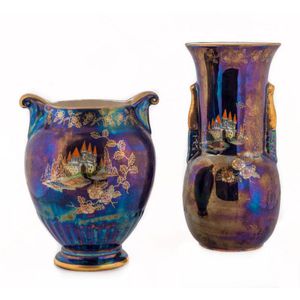Crown Devon Lustre Vases, 1930s, Fieldings Stamp
You must be a subscriber, and be logged in to view price and dealer details.
Subscribe Now to view actual auction price for this item
When you subscribe, you have the option of setting the currency in which to display prices to $Au, $US, $NZ or Stg.
- Circa - A Latin term meaning 'about', often used in the antique trade to give an approximate date for the piece, usually considered to be five years on either side of the circa year. Thus, circa 1900 means the piece was made about 1900, probably between 1895 and 1905. The expression is sometimes abbreviated to c.1900.
- Dating English Ceramics - Excellent detailed reference books such as Godden's Encyclopaedia of British Pottery and Porcelain Marks will help to identify and date specific manufacturer's marks.
However, there are a few simple guidelines which may also help.
The inclusion of the word 'England' on an item ensured compliance with the American McKinley Tariff Act 1891, which was important for British exporters. An item so marked would have been made after 1891.
In 1921 the act was revised to require the phrase 'Made in' followed by the country. So if an item is marked 'Made in England', it is generally considered to be made after that date, although some manufacturers were using this phrase pior to the act being changed.
The use of the word 'Ltd' of 'Limited' after a company's name indicates a date after 1860, though with ceramic manufacturers this did not become general practice until the 1880's. - Lustre Ware - Lustre decoration on ceramics is created by painting a thin deposit of metal oxide such as gold, silver or copper onto the surface, and then firing the item again, so that metal oxide forms a thin film on the surface. The finished effect is a shiny metallic surface. The technique was used in the 19th century by potteries such as Crown Devon, Grimwades, Maling, and Royal Doulton. However the best known use was by Wedgwood for its Fairyland lustre.
This item has been included into following indexes:
-
Crown Devon (England), item types
- lustre wares 36
- vases and ewers 106
Visually similar items

Chinese porcelain vase. Dragon decoration on blue ground. Character marks to base. Height 44 cm

A Japanese Meiji period Satsuma vase, baluster form, three panels finely decorated with multiple figures, cobalt blue ground, elaborate gilt enrichments, black tablet mark to base with gilt calligraphy and mon. Height 21.5 cm

A Royal Doulton flambe grape decorated vase with gilt highlights, circa 1930, by Charles Noke and Harry Nixon, stamped Royal Doulton England Flambe, HN, 26 cm high

Moorcroft flambe vase signed William Moorcroft to base. Height 20 cm
